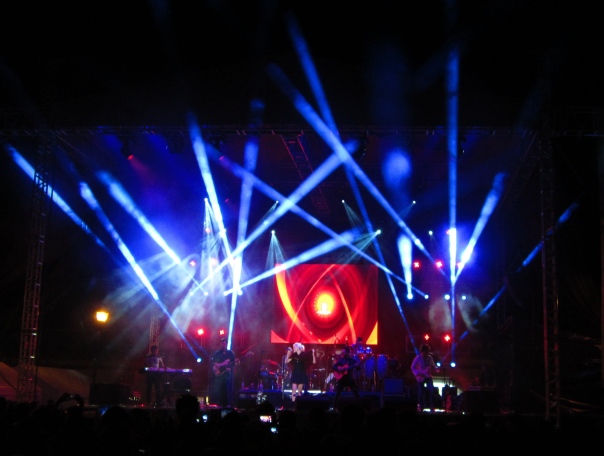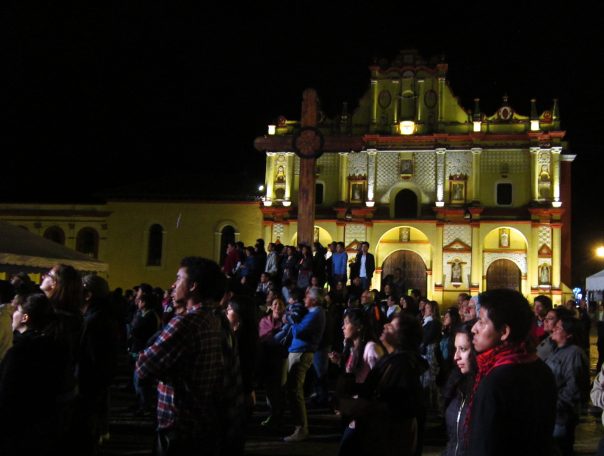An Introduction to Latin American Music
The Bus, Dance Floor and Block Party
You can’t escape music in Latin America.
Walk the city streets by day in Merida, the capital of Mexico’s tropical Yucatan state, and pounding bass assaults you from big speakers set up in front of paint, hardware, and shoe stores. The beat mixes with the sidewalk heat, making you feel like the party is just steps away.
In Central America, souped-up former U.S. school buses pump music that an elementary school teacher in the English-speaking half of America would find deeply inappropriate for the field trip — especially if she knew Spanish and understood what they were saying.
| A "chicken bus" in Quetzaltenango, Guatemala. |
Click-click-click; click-click-click — a Colombian once told me that the rhythm of super popular cumbia music sounds like a walking horse. Once I could recognize the beat, I always recognized cumbia — and even learned to dance it passably.
Of course, no trip to Latin America is complete without a night of live music at the salsa club. Missing this adventure is like going to Ireland and refusing a night at the pub. Even if you don’t drink (or dance), you’ll have a great time.
And if you can’t dance, there’s no better way to learn than in the club, with friendly potential partners, floor-rattling bass, and enough drums to get even the stiffest legs moving.
But “salsa clubs” rarely only play salsa, just as most salsa bands include a few cumbia or pop songs. And late at night, once the band is done, you’re bound to hear some electro music or reggaeton played over the house speakers.
And everywhere in Latin America, you’ll hear regional music — especially if you pass through town during their fiesta days, usually the birthday of the town’s patron saint.
For example, on Saint Peter’s birthday, the place to be is San Pedro, Anywhere (every country has a San Pedro). There will be abundant food and drink, lots of fireworks, and an outdoor stage with a band playing whatever the locals get down to.
| Los Angeles Azules in the center square of Toluca, Mexico. |
Cumbia, salsa, reggaeton, bachata, punta, merengue, son, trova, ranchera, banda, norteño, marimba, saya, huayño, tango… the list goes on and on, practically doubling when you add Brazilian styles: samba, bossa nova, pagode, forro, axe.
These genres make up a wide world of music that can take years to dissect. And other than a common language (with Portuguese the exception), they don’t seem to have much in common, besides lots of rhythm.
Fortunately, rhythm — drums and bass — is usually the best way to identify the genre of Latin American music you are listening to. (Of course, asking someone never hurts.)
Either the drumbeat alone or the interplay between drums and bass defines much Latin music. Salsa, along with many other genres, uses a clave, a repeating pattern of clicks, often one-two-three, one-two; one-two-three, one-two. (That's how to count it — listen to the music to get the timing.)
| Blind street performers playing some afternoon salsa. |
The clave might be buried in the mix, more felt by the musicians than noticeable in the song. However, in this example, a Cuban salsa cover of a cumbia song written by a Mexican rock band, you can hear the woody clicks of the clave if you listen closely.
Reggaeton, a Caribbean style that has more in common with rap than reggae, is an easy one — it always uses the same drumbeat. The sound might be different — a high-hat instead of a snare — but the pattern is the same. Once you know the pattern, you will always recognize reggaeton.
So here are five common types of Latin American music: cumbia, banda, trova, huayño, and samba. Though each genre originated in a specific country, they have all since gone international.
This isn’t even close to a comprehensive list. The countries where this music originated, such as Cuba, Colombia, Mexico, and Brazil, have many other types of regional music, which will be described in future articles.
Cumbia
Often confused with salsa, the cumbia beat is distinctive, both for its horse-trot drumming and its distinctive, repetitive basslines.
Also, the instruments are often the same as in salsa and the dance steps are similar. For a salsa song with elements of cumbia, listen to “La Vida Es Un Carnaval” by legendary Celia Cruz from Cuba.
Originally from Colombia, cumbia music is played everywhere from Tierra del Fuego to New York City (and surely farther north in some Canadian house parties as well).
Besides huge superstars like La Sonora Santanera or the group’s former singer Margrarita “La Diosa de Cumbia” (the queen of cumbia), some of the biggest cumbia bands are from outside of Colombia, like Los Angeles Azules (The Blue Angels) from Mexico.
In Argentina, there is a style called cumbia villera (video).
Cumbia is easy to mix with reggae, rock, rap, or practically any kind of music, producing crossover bands like Celso Piña (Mexico) and Chico Trujillo (Chile).
Banda
You’re not alone if you ever sat in a Mexican restaurant with Mexican music on the radio and the bouncy, um-pa-pa music reminded you of polka.
In fact, several kinds of music from the north of Mexico, like tejano, banda, conjunto and norteño, can be traced to Europe. In the 1850s, Germans and Poles migrated to northern Mexico and Texas, bringing accordions and the ¾ polka rhythm. (Most popular music counts 1-2-3-4; polka — and many Mexican songs — count 1-2-3.)
The way to tell banda from other Mexican music is to check out the instruments. Banda is, well, a band: a horn section (trumpets, trombones, clarinets, sometimes sax, and always tuba for bass) and a drummer or two, usually without piano, guitar, or bass guitar. Look for big, loud bands of guys in matching suits and an enthusiastic, cowboy-hat wearing audience.
| One of Banda El Recodo's several trucks for near-constant touring. |
Banda is arguably the most popular music in Mexico. If the party goes past 4 a.m., you’re probably listening to banda. If you are drinking beer at 10 a.m., you’re probably listening to banda. And if the local government is throwing a big party in the center square of town, they’ve probably hired a banda group or four.
In Mexico, banda even has its own cable TV channel, and big names like La Arroladora, El Recodo and singer-songwriter Espinoza Paz draw huge crowds at music and cultural festivals.
U.S. citizen Lupillo Rivera is an all around badass and activist for immigrant rights, with lots of famous songs like “Sin Fortuna” (Unlucky) (video).
Trova
The tiny island of Cuba pulses with music. Take drums from Africa, rhythms from Latin America, fun-loving people, plenty of heat, and just enough cultural melancholy, and countless genres emerge.
Trova has spread throughout Latin America, even returning to Spain, its ancestral home. Trova is an exception to listening to the drums and bass to identify a genre. No, trova is usually just a singer with his or her guitar.
Trova comes from trovador, which — you guessed it — means troubadour: musician/poets with stories of love, life, adventure and loss. It’s the best kind of folk music, like Woody Guthrie at his most political, Tom Waits at his most symbolic, or Bob Dylan at his most abstract.
In 2011, after a concert in Guatemala, Facundo Cabral from Argentina was gunned down in his limousine, caught in the crossfire between gangsters and the shady promoter he was sharing the ride with, a terrible irony for someone who sang about peace.
Along with Mercedes Sosa, Silvio Rodriguez, and Fernando Delgaldillo, he is one of the giants of modern trova.
Check out his deeply introspective “No Soy de Aquí, Ni Soy de Allá” (I’m not from here, and neither from there”) (video).
Huayño / Andean music
At art fairs and street festivals around the world, pan flute groups with two to twenty players transport coin-tossing crowds to the towering Andes Mountains with their evocative music.
If you ever wondered why these groups play Simon and Garfunkel so much, perhaps it’s because the duo once recorded a version of a huayño classic, “El Condor Pasa.”
The Andes, especially in Peru and Bolivia, produce countless genres and subgenres of indigenous-influenced music that often features pan flutes of many sizes: little ones that fit in the palm of your hand, or big ones that reach down to your knees.
Though popular bands like Proyeccion have modernized it, like many kinds of folk music, huayaño is originally dance music with poetic lyrics. The classic song “Ojos Azules” (video) is known throughout Latin America.
An interesting pop culture back-story is the origin of Jennifer Lopez’s 2011 club hit “On the Floor.” She (or her manager) wasn’t the first to hear a casino-like cascade of coins in the catchiness of that tune, which was originally ”Lllorando Se Fue” (“She Left Crying”) by Bolivia’s Los Kjarkas, who in turn had adapted it from an old Andes melody.
In 1989, it was made hugely famous and renamed “Lambada” by Kaoma, a French group with a Brazilian singer, who had covered note-for-note a previous Brazilian version of an even older Peruvian cover. Sounds complicated? It’s South America’s big-money answer to “the ABC song” / “Twinkle Twinkle” / “Ba Ba Black Sheep”.
Also, more recently “Llorando Se Fue” was the used as the chorus in “Taboo” by reggaetonist Don Omar.
Samba
Cross the border from Bolivia into Brazil, and everything changes. First, the language — on paper, Portuguese looks a lot like Spanish, but just wait until you have to speak it.
Also, the food — sure, there’s rice and beans and lots of fruit, but where’s the spice?
And, of course, the music. Yes, there’s lots of drums, loud bass, and lots of dancing, but listen a little closer (or try to learn the basic dance steps), and you’ll quickly find that you are listening to something quite different, and often much more complicated.
Brazil is its own world, and it has its own world of music.
Bossa nova, a mix of samba and jazz, is probably best known in the English-speaking world due to “The Girl From Ipanema.” Like trova, bossa nova is often just a singer and guitar, while samba has lots of drums and other instruments.
Samba rhythms mixed with jazz structures gave rise to bossa nova, which has since injected samba with a smoother, jazzier feel.
Chico Buarque is luminary if Brazilian music — and how do you make a great musician even better? Pair him with someone like Mart'nália (video).
Variations on samba rhythms have been used in countless hits, such as “Sympathy to the Devil” by The Rolling Stones, “The Obvious Child” by Paul Simon, “Matador” by Los Fabulosos Cadillacs (ska/fusion legends from Argentina), and of course by many Brazilian rock bands, which gave rise to a kind of music called MPB, or musica popular brasileira.
| Los Fabulosos Cadillacs at the Vive Latino music festival, Mexico City. |
Samba is only one of many distinctly Brazilian styles of music, which include pagode, similar to samba; accordion-led dance and party music forro; carnaval party-music axe; and funk (roughly pronounced “funky”), Brazil’s answer to reggaeton.
Please check back for more articles that will further explore the many types of Latin American music.




